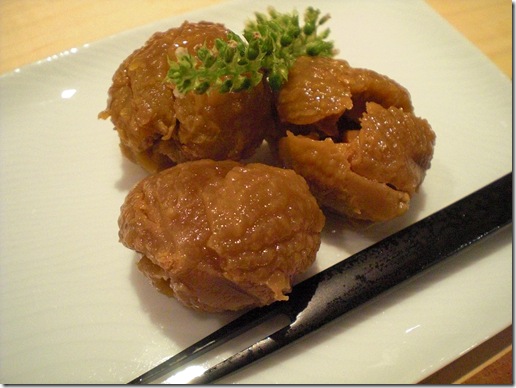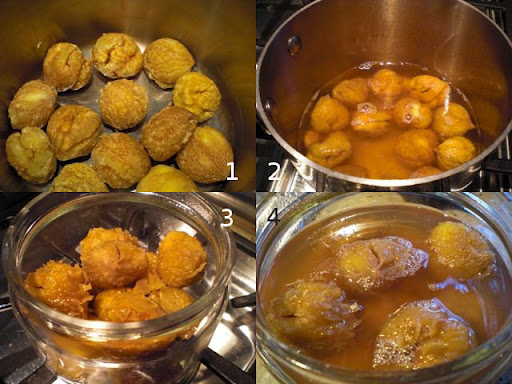We got a shipment of North American Matsutake from
Oregon mushrooms the last week of September. Among the North American matsutake, the ones from Mexico are the most similar to the ones in Japan but, for us, the ones from Oregon are a good balance between flavor and price. I have posted many matsutake dishes previous so this time I just made one composite post to signify the fall season.
Unlike Japanese matsutake, these Oregon matsutake are covered with dirt which is difficult to remove using just wet paper towels. So, I usually end up scraping the surface of the mushroom with a sharp paring knife. It is the pretty unpleasant to bite into grit either sand or dirt while eating matsutake.
We started with a few small dishes before we delved into feasting on the matsutake this evening. As shown below we had stir fried cabbage with abura-age similar to
stir fried beef and cabbage I post before. I served this with
spicy marinated tofu but instead of baking the tofu as I did previously, I cooked it in a frying pan. I first browned the pieces without sauce and then poured in the sauce and cook until the sauce was reduced. We found this is much better preparation than when they are baked. The tofu maintains its moisture with nice "piri-kara" spicy hot and salty flavor. I served this after a brief microwaving.
The cabbage dish is classic Japanese home cooking. Instead of meat, deep dried tofu pouch or abura-age is used cut into small strips and sauteed with vegetable oil and a splash of dark sesame oil and red pepper flakes. I then braised it in mirin and soy sauce. I garnished it with blanched broccoli.
The second small dish was made from something I usually discard. In preparation for making the matsutake dishes, I made a broth from kelp and dried bonito flakes (katsuo-bushi). I made two kinds of broths; Ichi-ban (#1) dashi and ni-ban (#2) dashi (一番だし、2番だし)*. I decided to make the leftover spent kelp and bonito flakes to a dish by braising them in mirin and soy sauce until the moisture was almost all gone. This is a type of "
Tsukudani" 佃煮. Although these items were "spent" by making broth, they are still full of "umami". My wife was pleasantly surprised this dish went well with the Napa Cab we were drinking.
* #1 broth: After simmering the kelp for 10 minutes in water, I added dried bonito flakes and let it simmer for 30 seconds then cut the flame. I let it steep for another 5 minutes and then strained it without pressing. #2 broth: I put the kelp and the bonito used to make #1 broth back into the pan and added water. I let this mixture simmer for 30 minutes and then strained it. #1 dashi is the premier extraction of dashi flavors. The best analogy would be to say it is like cold pressed extra virgin olive oil while #2 dashi is like second press with heat light olive oil. #1 dashi is best used in clear soups or chawan-mushi and #2 broth is good for simmered dishes.
This is the first matsutake dish of the evening. I made
matsutake touban-yaki. This time I did not add sake to steam it.
Even off the flame, the touban or ceramic disc retained heat. Upon opening the dome, the subtle but rather distinct aroma of matsutake wafted up. The steam rising from it is just visible in the picture below. We simply enjoyed this with lime (in leu of "kabosu" カボス) and Kosher salt. Of course we switched to cold sake at this point. Since we were drinking sake from Yamagata, we used "Tsugaru-nuri" sake cups we got from the Aomori prefecture (both are northern prefectures in the mainland).
The second matsutake dish I made was
chawanmushi. Since I did not have any special ingredients, I made this with what I had on hand. I put in some shrimp (thawed, shelled, deveined, and cut into small chunks), ginko nuts (from a can), and boiled North American chestnuts I had prepared previously. On the top were slices of matsutake, hana-fu 花麩 (decorative gluten cake, hydrated), the green part of scallion and yuzu skin (frozen).
Although there is a good amount of matsutake is in this dish, it is difficult to see in the picture. This is another of our favorite ways of enjoying matsutake. The egg custard was silky smooth. (I used #1 dashi broth for this dish seasoned with mirin, light colored soy sauce and salt).
At this point, we were getting filled up, so I skipped the matsutake clear soup 松茸のも吸い物 I had planned and went to the last dish of matsutake rice 松茸御飯. As usual, I used the "Kamado-san" かまどさん donabe 土鍋 rice cooker. I used a mixture of #1 and #2 broth, lightly seasoned with sake and light colored soy sauce. I also added small pieces of kelp.
This time I did not intentionally make browned crust or "okoge" おこげ to maintain the delicate flavor of the matustake. The rice developed a very nice sheen.
I ate my serving as is; enjoying the subtle flavor and aroma of the matsutake and rice. But when I wasn't looking my wife added pats of butter to hers. (She confessed it was sublime)


The sake we had was called
"kudoki jouzu" or pick-up artist, Junmai Ginjou
くどき上手 純米吟醸 from Kamenoi shuzou 亀の井酒造 in Yamagata prefecture 山形県. Yamagata has many good sake breweries including
"Juyondai sake" 十四代 of Takagi shuzou 高木酒造. This is made from
美山錦 miyama-nishiki which is the sake rice adapted to colder climate as I understand it. This is a nice clean sake with crisp acidity and the floral quality of Daiginjou. Ture sake website describes this sake as follows; "Great name and a great nose on this sake with hints of pear, apple, and purple plum aromas. Ahhhhh! A brew that gets it. A terrific feeling sake that fills the mouth with fat and gooey flavors but stays super smooth. The brilliant acidity-balancing act takes the sweetness out of the gambit of fruit flavors including pineapple and mango. Plump and complex this "sexy beast" is layered and luxurious with attitude and swagger. Drink closer to room temp if you want even more fruit tones, but chilled is happening." which we agree for the most part. We enjoyed matsutake this evening. Only regret I have is that I could not arrange to have some nice sashimi with this.





































